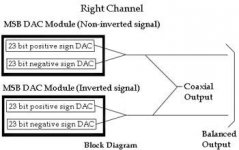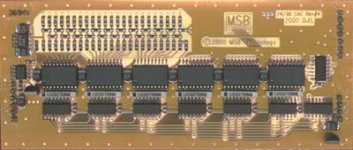Paralell is better IMO
Accuphase states that paralelling two Dacs reduces distortion by square root of two (roughly 1.4, therefore a 40 % reduction) across the board, this is clearly stated in their product brochures.
I have read that differential DACs cancel even-order distortion. Makes sense, that's what differential circuits do, besides cancelling common-mode noise.
In my system, for my kind of music, I prefer to reduce the entire distortion spectra by 40% (even and odd), instead of having a DAC with mostly odd-harmonics distortion.
Odd-harmonic distortion sounds screechy and not musical at all, it has no pitch relationship to the instrument's natural timbre, therefore sounds dissonant.
IMO 3rd and 5th harmonic distortion sounds like an underbiased solid state amplifier.
Even-harmonic distortion is similar to the musical instruments natural timbre, therefore it sounds musical (consonant), it is mostly ignored by the human auditory system (AFAIK up to 3 % ).
I hope this helps
Accuphase states that paralelling two Dacs reduces distortion by square root of two (roughly 1.4, therefore a 40 % reduction) across the board, this is clearly stated in their product brochures.
I have read that differential DACs cancel even-order distortion. Makes sense, that's what differential circuits do, besides cancelling common-mode noise.
In my system, for my kind of music, I prefer to reduce the entire distortion spectra by 40% (even and odd), instead of having a DAC with mostly odd-harmonics distortion.
Odd-harmonic distortion sounds screechy and not musical at all, it has no pitch relationship to the instrument's natural timbre, therefore sounds dissonant.
IMO 3rd and 5th harmonic distortion sounds like an underbiased solid state amplifier.
Even-harmonic distortion is similar to the musical instruments natural timbre, therefore it sounds musical (consonant), it is mostly ignored by the human auditory system (AFAIK up to 3 % ).
I hope this helps
Well, I guess the question comes down to which configuration is most important for percieved reproduction quality...
I am not an expert but as you indicate I've read that the logic for parallel dacs is the they will average linearity errors but on the other hand is that not what a balancen configuration will do as well?
Besides linerity errors I can see a balance configuration being able to supress noice induced in powersupplies and cables.
I was looking for real-world experiance as I understand there is no real scientific explanation why paralell dacs sound better.
I am not an expert but as you indicate I've read that the logic for parallel dacs is the they will average linearity errors but on the other hand is that not what a balancen configuration will do as well?
Besides linerity errors I can see a balance configuration being able to supress noice induced in powersupplies and cables.
I was looking for real-world experiance as I understand there is no real scientific explanation why paralell dacs sound better.
I can't quite see how parallelling DACs could do more than
reduce errors due to individual variations between the DACs.
Howver, perhaps we'd better clear up what we mean with
parallelling DACs, so we avoid confusing each other. I have
taken the term to mean that two DACs are fed identical data
and the outputs are summed/averaged, but perhaps that is
not what others mean? Similarly, balanced DACs would in
my understanding be two DACs where one is fed the
complement of the data to the other one, so we get a
balanced signal between the two DAC outputs.
reduce errors due to individual variations between the DACs.
Howver, perhaps we'd better clear up what we mean with
parallelling DACs, so we avoid confusing each other. I have
taken the term to mean that two DACs are fed identical data
and the outputs are summed/averaged, but perhaps that is
not what others mean? Similarly, balanced DACs would in
my understanding be two DACs where one is fed the
complement of the data to the other one, so we get a
balanced signal between the two DAC outputs.
"I am not an expert but as you indicate I've read that the logic for parallel dacs is the they will average linearity errors but on the other hand is that not what a balancen configuration will do as well? "
Correct, the paralel DACs will average LSB errors and will help randomize quantization noise. The overal effect is less distortion and probably a better signal to noise ratio. This tweak is performed by soldering one DAC on top of the existing one.
If you want to do it, better strive for the average of two excellent Dacs, for example BOW uses the selected, more linear PCM 1702- K suffix. I see no point in paralelling non-select DACs, it may even sound worse.
I have no direct experience comparing the two topologies, however, I hear a brighter sound on the few differential DACs that I have auditioned.
Again, it's a matter of taste, some people may prefer a more incisive presentation, I prefer a more mellow, acoustical presentation (NOT undynamic).
best wishes
Correct, the paralel DACs will average LSB errors and will help randomize quantization noise. The overal effect is less distortion and probably a better signal to noise ratio. This tweak is performed by soldering one DAC on top of the existing one.
If you want to do it, better strive for the average of two excellent Dacs, for example BOW uses the selected, more linear PCM 1702- K suffix. I see no point in paralelling non-select DACs, it may even sound worse.
I have no direct experience comparing the two topologies, however, I hear a brighter sound on the few differential DACs that I have auditioned.
Again, it's a matter of taste, some people may prefer a more incisive presentation, I prefer a more mellow, acoustical presentation (NOT undynamic).
best wishes
OK, maybe but high much really? Take the PCM1792 for instance. Isn't this chip rather good as it is?Petter said:Parallel DAC's will have many advantages such as dynamic range, noise, lower bit distortion, output impedance etc.
Parallel DACs
If you mean the PCM 1702 DAC, BOW technologies advertises that the latest version with parallel chips sounds much better than the early version with one chip per channel.
I borrowed a BOW ZZ Eight from a friend for a week, I was in heaven!
Unfortunately it is too expensive.
I hope this helps
If you mean the PCM 1702 DAC, BOW technologies advertises that the latest version with parallel chips sounds much better than the early version with one chip per channel.
I borrowed a BOW ZZ Eight from a friend for a week, I was in heaven!
Unfortunately it is too expensive.
I hope this helps
Re: Parallel DACs
http://www.diyaudio.com/forums/sear...d=163174&sortby=lastpost&sortorder=descending
No, the state of art PCM1792, 132 dB S/N. Datasheets aren't availible yet.casouza said:If you mean the PCM 1702 DAC
http://www.diyaudio.com/forums/sear...d=163174&sortby=lastpost&sortorder=descending
One should expect n times dynamic range for parallell operation.
Random noise should theoretically go down by sqrt
Noise should also be possible to reduce given that one needs lower value resistors to obtain the same IV characteristics
If one were to shift the units by say a few clock cycles one would also get a filtering effect which would be cool. I have looked at this extensively and it is relatively easy to do.
With parallell units one might also be able to get by without buffer stage which saves at least one amplification stage with it's inherent distortion.
Petter
Random noise should theoretically go down by sqrt
Noise should also be possible to reduce given that one needs lower value resistors to obtain the same IV characteristics
If one were to shift the units by say a few clock cycles one would also get a filtering effect which would be cool. I have looked at this extensively and it is relatively easy to do.
With parallell units one might also be able to get by without buffer stage which saves at least one amplification stage with it's inherent distortion.
Petter
Connecting DACs in parallel will only improve the dynamic range if the noise limiting the dynamic range is uncorrelated between the two DACs. If the DACs are quantization noise limited, then no improvement would be expected because the quantization noise between the two DACs is completely correlated.
Shifting the input to the second DAC does indeed produce a filtering effect similar to a rectangular FIR filter with two taps. This would tend to reduce quantization noise at higher frequencies, but it will also filter the signal.
Possibly two oversampled (noise-shaping) DACs would benefit from being paralleled if their reset times are staggered. Staggered reset would to a certain extent break the correlation between the quantization noise in the two DACs.
Shifting the input to the second DAC does indeed produce a filtering effect similar to a rectangular FIR filter with two taps. This would tend to reduce quantization noise at higher frequencies, but it will also filter the signal.
Possibly two oversampled (noise-shaping) DACs would benefit from being paralleled if their reset times are staggered. Staggered reset would to a certain extent break the correlation between the quantization noise in the two DACs.
Petter,
"Hmmmm"....how does paralleling dacs increase dynamic range?
Maybe I have a misconception of what dynamic range is...I think of dynamic range as 1 part in 64k for 16 bits digital signal coming from the CD.
Mikewu99,
random noise + random noise= more noise or less noise?
I think it equals less noise only in the presence of coherent signal which is what we would have here. Yes?
"Hmmmm"....how does paralleling dacs increase dynamic range?

Maybe I have a misconception of what dynamic range is...I think of dynamic range as 1 part in 64k for 16 bits digital signal coming from the CD.
Mikewu99,
random noise + random noise= more noise or less noise?
I think it equals less noise only in the presence of coherent signal which is what we would have here. Yes?
Well my DAC started of with 1 TDA1541 then 2 x TDA1541 and then 2 x TDA1541s1.
The way i've done it, is a by having 2 seperate identical dac prints which get the same input.
In my setup there is a big difference between a singel dac and 2 dacs parallel, there is way more details and control with 2 dacs.
Some day when I get the time, I plan to build 2 dac prints more to see if the gain is just as big as from 1 to 2 dacs.
I also considered balanced, but droped the idea because it's way more differcult than non balanced and also because non of my other gear is balanced.
The way i've done it, is a by having 2 seperate identical dac prints which get the same input.
In my setup there is a big difference between a singel dac and 2 dacs parallel, there is way more details and control with 2 dacs.
Some day when I get the time, I plan to build 2 dac prints more to see if the gain is just as big as from 1 to 2 dacs.
I also considered balanced, but droped the idea because it's way more differcult than non balanced and also because non of my other gear is balanced.
- Status
- This old topic is closed. If you want to reopen this topic, contact a moderator using the "Report Post" button.
- Home
- Source & Line
- Digital Source
- Balanced or parallel DAC chips

